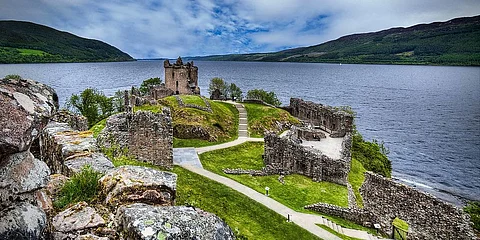
- Destinations
- Experiences
- Stay
- What's new
- Celebrating People
- Responsible Tourism
- CampaignsCampaigns
- SubscribeSubscribe
- Buy Now

The lochs of Scotland are famous for their stunning natural beauty, geological significance, and unique ecosystems. Many also hold cultural and historical importance. Glacial activity formed them, creating the dramatic U-shaped valleys and diverse landscapes of the Highlands. One of the most notable lochs is Loch Ness, a significant landmark in Scottish history and culture that attracts tourists and researchers. Among the many places to see at Loch Ness are its picturesque shores, historic Urquhart Castle, and the Loch Ness Centre and Exhibition, all set within the Great Glen Fault—a geological zone that has experienced seismic activity. Loch Ness is also renowned for the legend of the Loch Ness Monster, or Nessie, a mythical creature said to inhabit the waters.
Loch Ness is one of the largest lochs in Scotland by volume and also one of the deepest lochs in Scotland, reaching a depth of over 700 ft. The dark waters of Loch Ness are caused by tannins leaching from the surrounding peat-rich hills. The area around Loch Ness has been inhabited for thousands of years, with evidence of ancient settlements and fortifications found nearby. Here are some of the best places to visit in Loch Ness, Scotland.
Urquhart Castle, located on the shores of Loch Ness, is a historically significant and iconic landmark with a rich past. It is renowned for its dramatic setting on a promontory overlooking the lake, impressive ruins, and its connection to the legend of the Loch Ness Monster. Throughout its history, the castle has been the site of battles, sieges, and power struggles, making it a focal point for exploring the Scottish Highlands. The visitor center and guided tours offer a comprehensive overview of the castle's history and the surrounding area. This unique location, famous for the mythical creature known as "Nessie," adds to the castle's allure.
Address: Drumnadrochit, Inverness IV63 6XJ, United Kingdom
The Loch Ness Centre explores the legend of the Loch Ness Monster through immersive experiences and genuine artefacts. Through theatrical and audio-visual guided tours, it presents the true stories of Loch Ness and its famous monster, going beyond just the myth. The centre delves into the loch's 500-million-year history and ancient Scottish myths, legends, and scientific research related to the Loch Ness Monster.
Address: Drumnadrochit, Inverness IV63 6AN, UK
The Falls of Foyers, located on the River Foyers near Loch Ness, have been a popular tourist attraction since the late 18th and 19th centuries. The falls plunge into a gorge surrounded by ancient woodlands, creating a dramatic and awe-inspiring scene. Notably, the falls are mentioned in a poem by Robert Burns, who was inspired by their beauty during his visit in 1787. In fact, some rocks along the path to the falls have verses from Burns' poem inscribed on them.
Visitors can easily access the falls from the village of Foyers, where a well-signposted path leads to various viewpoints. There are both upper and lower viewing points, providing different perspectives of the falls and the surrounding landscape. The Falls of Foyers are free to visit and open year-round. For refreshments, the nearby village of Foyers offers a café, shops, and restaurants, enhancing the overall experience.
Fort Augustus is located on the shores of Loch Ness. Although the original fort no longer exists, the village retains a charming historical atmosphere and serves as a popular stop along the Great Glen Way. Surrounded by breathtaking natural landscapes (in fact, Scotland has many beautiful places to see; Outlook Traveller has listed some here), including the mountains of the Scottish Highlands, serene lochs, and ancient forests, Fort Augustus offers numerous opportunities for outdoor activities such as walking, cycling, and exploring the surrounding areas. It serves as a gateway to various adventures, including hiking on the Great Glen Way, and taking boat trips on Loch Ness.
While you are in the area, do check out the Caledonian Canal, which stretches from Fort William in the west to Inverness in the east. It is the longest inland waterway in Scotland.
Caledonian Canal passes through Loch Oich, Loch Lochy, and Loch Ness. Cruising the canal from one end to the other is a popular activity for travellers and makes for an ideal week of exploration.
The area surrounding the Caledonian Canal also offers excellent walking opportunities. With its breathtaking scenery, there is always something to enjoy. You can take a relaxing stroll along the towpath, unwind with a jog, hike the long-distance Great Glen Way, or even climb Britain's highest mountain.
Discover the stunning glen in the Scottish Highlands, near Loch Ness, during a weekend getaway. The beautiful lochs make this a magical destination. You can hike the glen's trails, including the challenging Glen Strathfarrar Munros Circuit, or opt for easier walking and cycling routes. For seasoned hikers, the Munros Circuit offers an exciting challenge along with breathtaking views. You'll also find several charming lodges in the area. This region is designated as a national scenic area, so keep an eye out for red deer, golden eagles, and a variety of rare Highland wildlife.
The best time to visit Loch Ness, Scotland, is during late spring to early autumn, from May to September. During these months, the weather is milder, with longer daylight hours perfect for exploring the loch, nearby castles, and scenic Highlands. Summer (June to August) offers the warmest temperatures, ideal for boat tours and outdoor activities, though it's also the busiest season. For fewer crowds and vibrant landscapes, late spring and early autumn are excellent. Wildlife spotting is rewarding year-round, but summer increases your chances. While winter has its charm, expect shorter days and colder, unpredictable weather, limiting some activities.
